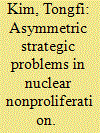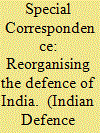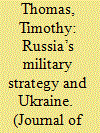| Srl | Item |
| 1 |
ID:
138093


|
|
|
|
|
| Summary/Abstract |
This article explains cooperation problems between powerful democratic states and weak non-democratic states in the context of nuclear nonproliferation. Focusing on the interactions of the United States with North Korea, Iran, and Libya, it suggests that power asymmetry and information asymmetry foster mutual distrust by exacerbating two main strategic obstacles to cooperation: the time inconsistency of the stronger state’s policy and the incomplete information regarding the nondemocratic states. The nature of negotiations over nuclear weapons programs further exacerbates these problems. The overall implications of this article leave us pessimistic about the possibility of negotiated nuclear disarmament, but the theoretical analysis may help the negotiation strategy of the United States.
|
|
|
|
|
|
|
|
|
|
|
|
|
|
|
|
| 2 |
ID:
133049


|
|
|
|
|
| Publication |
2014.
|
| Summary/Abstract |
Changes would provide a boost to defence preparedness, usher in an RMA, evolve requisite strategies and policies including tor national security, response to asymmetric war, defence procurements, R&D, technology acquisition and reorganizing the delenceindustrial base. Development and economic progress are undoubtedly priority tasks for the new government but national defence and security issues must be given equal importance it India is to gain its rightful place in the comity of nations.
|
|
|
|
|
|
|
|
|
|
|
|
|
|
|
|
| 3 |
ID:
140766


|
|
|
|
|
| Summary/Abstract |
This article details the development of Russia’s military strategy and how elements of that strategy may have been applied in Ukraine. It examines both traditional and contemporary elements of strategy, with a particular focus on the effect of Russian President Vladimir Putin’s competitive logic and the General Staff’s reliance on non-military methods of thought. With regard to the latter, General of the Army Valeriy Gerasimov, Chief of the Russian General Staff, noted that today, non-military measures in operations are used over military operations by a ratio of 4:1. Also examined is the concept of reflexive control, which may have been used as a propaganda method during the Ukraine intervention to exert an information-psychological influence on both Russia’s domestic and international audiences.
|
|
|
|
|
|
|
|
|
|
|
|
|
|
|
|